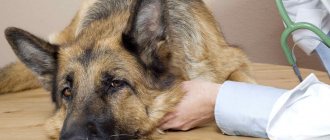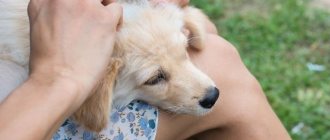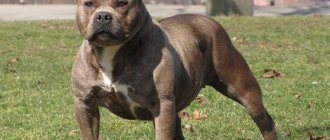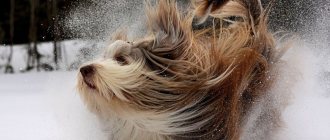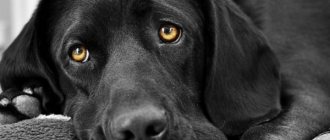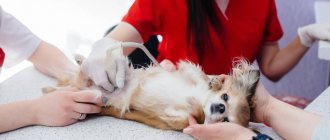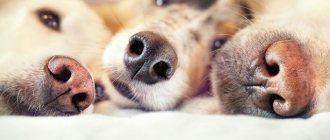In this article I will talk about skin diseases in dogs. I will describe the main dermatological diseases, their causes and symptoms. I will explain possible methods of diagnosis and treatment. I will explain the danger of skin diseases for people and animals at risk of infection.
Skin diseases are a group of diseases of different origins, characterized by damage (inflammation) of the skin.
Types of skin diseases
Skin diseases are a common veterinary problem. In most cases, it occurs as a result of allergic reactions, infections (viral, fungal, parasitic), genetic factors and hormonal imbalances in the dog. May appear as itchy, crusty sores on the back.
Fungal infections (dermatophytoses)
Caused by microorganisms. They are transmitted between animals by spores and contact.
The symptoms of the disease are pronounced: severe itching, hair loss, suppuration of the affected areas.
Therapy consists of the use of: antifungal shampoos (dermazole and nizoral), antifungal drugs (Terbinafine, Ketonazole, Itraconazole); disinfestation of the pet's habitat.
Dermatophytosis
Allergy
The disease is caused by exposure to allergens in the dog's body.
The main causes of allergic dermatitis: individual intolerance to the components of dog care products (parasite repellents, shampoos), mold, house dust, medications, an allergic reaction of the body to certain foods, insect bites.
Symptoms of allergies in a pet: itching, runny nose, increased salivation, cough, swelling, skin rashes, hair loss.
Therapy consists of the use of oral and local antihistamines (Fenistal, Claritin, Benadryl, Telfast, etc.), a special diet, and maximum exclusion of allergens.
Manifestation of an allergic reaction
Parasitic skin diseases
Sources include: fleas, ticks.
Symptoms of the disease: severe itching with scratching on the body, hair loss, redness of the skin.
Therapy consists of treating the dog with antiparasitic agents (Frontline, Advantix), the use of wound healing and anti-inflammatory drugs, immunostimulating and immunomodulating.
Parasitic skin diseases in dogs
Scabies
A parasitic disease caused by mites (small insects).
These parasites cannot be detected without special laboratory tests.
Main symptoms: severe unbearable itching (the dog can “tear itself”, which leads to secondary infections).
Treatment is aimed at eliminating parasites and relieving symptoms. Prescribed: antiparasitic agents, local anti-inflammatory and disinfectant, wound healing and enhancing local immunity.
Pruritic scabies in a dog
Seborrhea (dandruff)
The main causes of the disease are changes in the functioning of the endocrine system, poor-quality nutrition and allergies (for example, to care products: shampoos and antiparasitic drugs).
The disease is characterized by the appearance of dandruff on the animal's body. The scales first form on the lower abdomen and paws, then spread to the ears, tail, muzzle and chest.
If the cause of the disease is not an infection, antiseborrheic shampoos, creams and ointments (Tiomar, Pragmatar) are prescribed.
Seborrhea close up
The fifth reason is changing weather conditions
Changes in weather are an important physiological factor that influences changes in the condition of the mucous membranes and the nasal planum in particular. The cause of a dog's warm and dry nose can be cold or extreme heat. Being constantly exposed to the sun's rays, the animal's skin is protected by fur. But the nose remains unprotected, so it can even get burned and hardened. In hot weather, it is recommended to provide your pet with proper care and comfort:
- create shadow;
- provide constant access to clean drinking water;
- avoid overheating.
In severe frosts, the skin on a dog’s nose can not only dry out, but also crack. Severe dryness indoors in winter, as well as sudden temperature changes, negatively affect the condition of the mucous membranes and open surface of the nose. It is important to maintain the required humidity in the room. This will benefit not only pets, but also the person himself. After all, it is known that for the proper functioning of the epithelium, which produces mucus and removes everything unnecessary from the body, the immune system works better.
Risk group
The risk group for the development of dermatological diseases includes:
- puppies up to six months of age;
- elderly pets;
- animals with weakened immune systems;
- pets who have undergone surgery or acute infectious diseases;
- dogs undergoing serious drug treatment;
- animals receiving poor quality nutrition;
- pets in contact with untested or stray animals;
- animals living in unsanitary conditions.
Medicines you should have in your veterinary medicine cabinet
- "Migstim" is a solution with antiseptic and anti-inflammatory properties. Indispensable for treating wounds and abrasions.
- Okvet medicinal shampoo with chlorhexidine - reduces the duration of treatment of skin diseases, helps remove inflammatory products, microorganisms and allergens from the skin and fur of the animal, and also eliminates the cause of the unpleasant odor..
- Elite Professional spray shampoo will help prevent fungal infections of the beard of wire-haired dogs.
Read the instructions before using medications.
Causes and main signs of skin problems in dogs
The causes of dermatological problems are related to the specific type of lesion and the factors that caused it.
The main cause of serious diseases is infection of the animal's integument by parasites (fungi and mites).
Skin disease is always accompanied by characteristic, pronounced symptoms. An attentive owner will definitely notice bald spots on his pet’s body and constant itching.
If signs of disease are detected, you must contact a veterinary clinic for diagnosis and prescribing the correct effective treatment.
Many skin diseases are caused by parasites
The seventh reason is infections
An increase in body temperature is one of the first signs indicating the development of an inflammatory process in the animal’s body. As a rule, the main cause is infection. Various viruses and bacteria that damage the cells of the body as a result of their vital activity provoke the development of inflammation. If the infection affects the body in a generalized manner, the temperature rises throughout the body. Fever also affects the condition of your pet’s nose.
The most dangerous infectious diseases that threaten the life of animals are canine distemper and rabies. It is very important to vaccinate your pets in a timely manner, according to the vaccination calendar. Otherwise, the risks of developing distemper or rabies infection increase significantly.
Distemper is a rapidly developing disease that can cause death. One of the first symptoms of infection is a dry and hot dog's nose. In addition, disturbances occur throughout the body. Noted:
- severe weakness;
- apathy and depression in the animal;
- discharge of purulent exudate from the nasal passages;
- stool disorder, manifested by diarrhea with foam;
- attacks of nausea and subsequent vomiting;
- refusal to take not only food, but also water.
The second disease is 100% lethal. If carnivore plague can be successfully cured, if a visit to the clinic occurred at the very first signs of the disease, then with rabies it is more and more difficult - it cannot be treated. A sign of a dangerous infection entering the body is a depressed state, dry nose, and photophobia. Already at a later stage, characteristic aggression, fear of hydrophobia and other manifestations of a dangerous viral pathology arise.
Treatment
In most cases of infectious diseases, therapy involves the use of:
- antiparasitic agents (treating the root cause);
- antibacterial drugs (treatment of secondary infection);
- antihistamines (itching relief);
- wound-healing drugs (for the speedy restoration of the skin);
- immunostimulating and immunomodulating drugs (to improve the body's resistance to secondary infections);
- anti-inflammatory drugs (symptom relief).
Infectious skin diseases of dogs cannot be treated with folk remedies!
Treatment of skin allergic reactions on the back is carried out symptomatically with the exclusion of provoking factors (allergens).
Self-treatment of pets with antiparasitic and antibacterial agents is unacceptable. Drugs in this group are highly toxic and have a large number of side effects. If the dosage is incorrectly chosen, it can cause significant harm to the health of the pet.
In case of infectious dermatitis, strict isolation of the sick dog from other animals is necessary!
It is advisable to isolate a sick animal
What can the owner do?
- Adjust the dog's diet
. The development of dermatitis is promoted by deficiencies of vitamins A, B and unsaturated fatty acids. To compensate for their lack in feed, the veterinarian may prescribe vitamin-mineral complexes and other feed additives. For dogs suffering from skin diseases, the AVZ company offers the mineral and vitamin feed additive “Bone with Brewer’s Yeast.” - Follow proper care for your pet.
First, you need to avoid rubbing the skin with the collar and muzzle, if any. In addition, skin dermatitis tends to be complicated by a bacterial infection, so the affected areas can be treated with antiseptics, but only as prescribed by a doctor. For these purposes, the AVZ company offers a solution “Migstim” based on the antimicrobial drug miramistin, supplemented with chamomile extract, which has an anti-inflammatory effect, chitosan succinate and ethyl alcohol. - Follow treatment tactics.
External agents in the form of ointments, gels and sprays should be applied as prescribed by the doctor, do not interrupt the course and do not skip treatments. For complications of dermatitis with a microbial infection, the veterinarian may prescribe oral antibacterial drugs, and for fungal infections, antifungal drugs. These medications may have side effects such as nausea and decreased appetite. But the treatment must be continued, just consult a doctor to adjust the prescriptions. As a rule, the inclusion of antioxidants and hepatoprotectors in the course can reduce unpleasant symptoms.
To prevent skin diseases of bacterial etiology, Okvet medicinal zoo shampoo with chlorhexide can be prescribed.
Preventive measures
Prevention of ringworm is based on regular medical examinations of children attending preschool educational institutions. Parents should talk to their children about the inadmissibility of contact with stray animals. An important preventive measure is compliance with personal hygiene rules by patients of all age groups.
When purchasing pets, you must visit a veterinarian. The doctor will examine the cat or dog and give recommendations on how to eliminate any health problems with the pet. Following your veterinarian's advice will help prevent microscopic outbreaks within your family.
Nosebleeds
Nosebleeds are more of a symptom than an independent diagnosis. They can result from damage to the blood vessels in the nose due to infection, cancer, or a foreign body. Additionally, dogs with bleeding disorders (as a result of ingesting rat poison, lungworm infection, or an inherited blood clotting problem such as von Willebrand disease) may well suffer from regular nosebleeds.
It is imperative that a veterinarian look at and work on the problem to determine the root cause.
Answer
Redness in the Samoyed's mouth and belly can be a sign of an allergy. Allergic reactions are a common problem not only in humans. Such diseases are not uncommon for four-legged friends.
Hypoallergenic breeds have long been identified. When selling an animal from the list, conscientious buyers warn future owners about possible difficulties.
Risk group:
- French, American bulldog;
- Shar Pei;
- Labrador;
- Golden retriever;
- German Shepherd;
- bull terrier;
- pug;
- West Highland White Terrier.
The absence of a Samoyed husky on the list does not mean that trouble is excluded. According to statistics, 10% of representatives of any breed are allergic. For Samoyeds, the situation is complicated by the white coat color. Dysplasia or insufficient skin resistance, increased sensitivity of the body is associated with the lack of pigment.
Age-related molting
If you have become the happy owner of a small puppy, you should know in advance about the upcoming changes that will soon begin to happen to your tiny friend.
The puppy’s very first coat is renewed at about a month and a half; at the same time, in some breeds the color changes from dark to light and vice versa. Age-related molting in a dog begins no earlier than six months, although there are also quite “early” individuals in whom this process begins upon reaching the age of three months. At this time, the “puppy” downy coat is replaced by a harder and denser coat. Typically this process lasts up to a year, although in some breeds the change in wool quality occurs over several years.
Please note that in addition to seasonal and age-related shedding, there are several other physiological circumstances that contribute to hair loss:
- Often whelped bitches who have recently finished feeding their offspring shed profusely;
- Severe hair loss is also typical for bitches before the onset of estrus.
Classification of baldness
There is no generally accepted classification system for alopecia in pets; different sources divide the types of the disease in their own way. Experts agree that canine alopecia can be divided into three types, which also have their own subtypes:
- According to etiology, they are divided into 2 subtypes: inflammatory and non-inflammatory;
- Localization classification is divided into 4 subtypes: nested, telogen, mirror or multifocal;
- Genetics: hereditary and acquired (Alopecia X).
Veterinarians use this classification of the disease to make an accurate diagnosis in accordance with the standards.
Symptoms of pathology
Symptoms of ringworm appear 4-6 weeks after the patient becomes infected. A red spot appears on a smooth area of skin of a child or adult. It rises above the surface and has smooth boundaries. Over time, the size of the lesion increases. The surface becomes covered with nodules, blisters and scabs. The spots develop into rings that can intersect or merge with each other. The diameter of skin formations ranges from 5 to 30 millimeters.
Signs of ringworm include an acute inflammatory reaction. It often develops in children and girls. The lesions begin to peel off intensively. Patients suffering from dermatitis do not immediately identify symptoms of microsporia. Areas of active fungal growth may appear as inflammatory skin lesions.
A common manifestation of ringworm in a child is damage to the scalp. This symptom affects patients aged 5-12 years. Older children experience changes in the chemical composition of sebum. Its elements become dangerous for the microsporia pathogen.
The suppurative type of ringworm is characterized by the appearance of soft nodules on the patient’s skin. The nodes are dotted with numerous abscesses. When they are compressed, purulent contents are released.
Are you experiencing symptoms of ringworm?
Only a doctor can accurately diagnose the disease. Don't delay your consultation - call
Prevention
A very important point is the prevention of lichen in dogs. First of all, this includes timely vaccination, which will protect your pet from illness.
A complete and balanced diet with high quality feed is important.
It is also necessary to regularly conduct independent inspections of animals, clean their places of residence and habitat, and promptly wash bedding and blankets. It is important to deworm, as parasites can weaken your pet's immune system.

